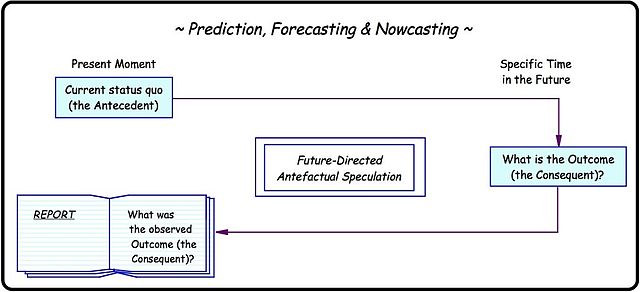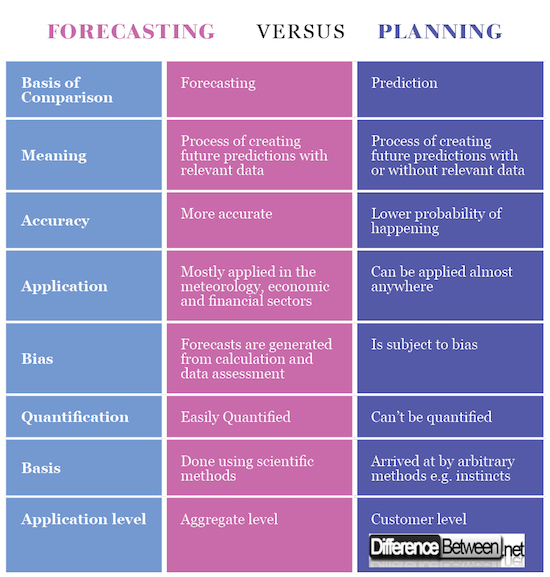Difference Between Forecasting and Prediction
Forecasting and prediction are both relate to more or less the same concept, that is future oriented. There however is a fine line that differentiates them.
What is Forecasting?
Forecasting refers to the process of analyzing and elucidating a future state concerning any operation being undertaken. This process takes the past and the current information into account in a bid to predict facts for the future events. In short, forecasting refers to a process of looking forward, and predetermining future trends and the impact on the organization.
This process is done by managers within different levels, in certain instances, analysts, economists and experienced statisticians can be employed to do the job. There are two methods of forecasting including quantitative and qualitative. Quantitative forecasting is an explanatory method which attempts to correlate variables using past records and trends to make forecasts. This method uses time series analysis, extrapolation, econometric analysis and regression analysis.
Qualitative forecasting is the method that relies on expert judgment rather than numerical figures to make the forecasts. It relies on the quality judgment of or experienced employees or outsourced experts. Qualitative method involves Delphi method, consumer surveys and executive opinion.
What is Prediction?
A prediction is a statement which tries to explain a possible outcome or future event. It comes from the Latin term Pre which refers to before and dicer which means say in English. Companies and governments use predictions determined by experts to guide through uncertain projects despite their uncertainty. They are highly risky and the actual results may deviate from predictions made.
Differences Between Forecasting and Prediction
Definition of Forecasting and Prediction
A forecast refers to a calculation or an estimation which uses data from previous events, combined with recent trends to come up a future event outcome.
On the other hand, a prediction is an actual act of indicating that something will happen in the future with or without prior information.
In short, all forecasts are predictions but not all predictions are forecasts. Anyone can do a prediction since it does not require any special skills but for one to do forecasting he/she requires special skills.
Accuracy
A Forecast is more accurate compared to a prediction. This is because forecasts are derived by analyzing a set of past data from the past and presents trends. The analysis helps in coming up with a model that is scientifically backed and the probability of it being wrong are minimal.
On the other hand, a prediction can be right or wrong. For example, if you predict the outcome of a football match, the result depends on how well the teams played no matter their recent performance or players.
Application
Forecasts are only applicable in the economic and meteorology field where there is a lot of information about the subject matter. When it comes to weather forecasting, meteorologist uses collected data such as wind speeds, temperatures, humidity to forecast future weather pattern. The same case applies to economics where current trends and previous performances are used to develop models which generate forecasts.
On the contrary, prediction can be applied anywhere as long as there is an expected future outcome.
Bias
Forecasting uses mathematical formulas and as a result, they are free from personal as well as intuition bias. On the other hand, predictions are in most cases subjective and fatalistic in nature.
For example, if you are predicting the result between two teams, and then you happen to be a supporter of one team, there will be some bias. But this is not the case for scientific methods since they have a way of eliminating bias and enhancing the accuracy of the forecast.
Quantification
When using a model to do a forecast, it’s possible to come up with the exact quantity. For example, the World Bank uses economic trends, and the previous GDP values and other inputs to come up with a percentage value for a country economic growth.
However, when doing prediction, since there is no data for processing, one can only say the economy of a given country will grow or not. As a result, a prediction value cannot be quantified and in most instances it’s vague.
Basis
In most cases, predictions are based on arbitrary methods and experiences such as astrology, superstition, instincts etc.
On the other hand, forecasts are done using scientific data that is analyzed scientifically to generate a model. This implies that a forecast might change if the trends used to derive the models change.
Application level
Finally, predictions are usually done at the instance or a customer level while forecasts are done at the aggregate level. This implies that when making a prediction needs to have a situation in hand which requires estimated future result.
However, forecasts arise from analysis of data and they may take time to develop.
Forecasting vs. Planning: Comparison Chart

Summary of Forecasting vs. Planning
- Forecasting and Prediction are both future-oriented processes.
- Forecasting is a process that determines future events using scientific methods that are either qualitative and quantitative in nature.
- Predictions use arbitrary methods such as instincts, astrology and superstitions.
- Predictions are often less accurate than forecasts as the later uses actual data to generate opinions.
- Difference Between S Corp and C Corp - September 9, 2018
- Difference Between Terrace and Balcony - September 9, 2018
- Difference Between Anabaptists and Evangelicals - August 31, 2018
Search DifferenceBetween.net :
1 Comment
Leave a Response
References :
[0]Image credit: https://upload.wikimedia.org/wikipedia/commons/a/a2/Interframe_prediction.png
[1]Image credit: https://upload.wikimedia.org/wikipedia/commons/thumb/2/29/Prediction%2C_Forecasting_and_Nowcasting.jpg/640px-Prediction%2C_Forecasting_and_Nowcasting.jpg
[2]Armstrong, J. S. (2001). Principles of Forecasting: A Handbook for Researchers and Practitioners. Springer Science & Business Media.
[3]Brown, R. G. (2004). Smoothing, Forecasting and Prediction of Discrete Time Series. Courier Corporation.
[4]Hyndman, R. J., & Athanasopoulos, G. (2014). Forecasting: principles and practice. OTexts.




Nice Explanation.Thank you